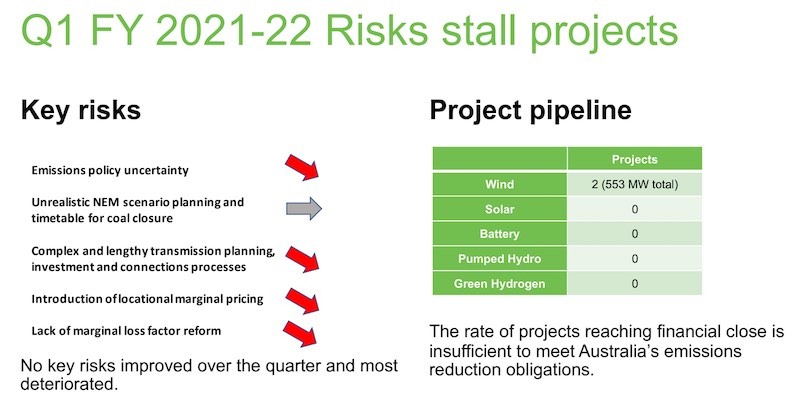The federal government’s last minute attempts to frame a 2050 net zero target in time for COP26 has done little to lift the confidence of renewable energy investors, a new survey has found, with Australia still considered an “unacceptably risky market.”
The Clean Energy Investor Group said on Wednesday that its inaugural quarterly investor confidence survey found its members were unmoved by the Morrison government’s net zero by 2050 pledge, and unconvinced that it had any discernible plans to achieve it.
The survey polled the CEIG’s 17 members, a group of leading domestic and global investors with a combined Australian portfolio value of more than $A24 billion and more than 70 renewable energy assets under management.
Simon Corbell, the CEO of CEIG and the former ACT energy minister, said the responses revealed that Scott Morrison’s eleventh-hour 2050 net zero announcement and brief stint at COP26 climate talks in Glasgow had not shifted the dial on negative sentiment about Australia’s renewable energy market.
Furthermore, this ongoing lack of confidence had translated into a lack of action in the market, with the survey also revealing that CEIG members had reached financial close on only two wind projects totaling 553MW in Q1 of FY 2021-22.
The survey also returned a “negative or mixed view” on the suite of Post 2025 National Electricity Market reforms, put together by the Energy Security Board and recently approved by the National Cabinet as the way forward for Australia as it transitions from fossil fuels to a wind and solar powered grid.
Most investors surveyed, in fact, reported that the direction of reform in the NEM had deteriorated or failed to improve over the quarter – even despite the net-zero announcement and the passage of the NEM reform package.
The only “bright light,” meanwhile, was the state government policies, and the push by state and territory energy ministers for a rethink on some of the more controversial elements of the Post-2025 NEM reforms, including the the controversial “CoalKeeper” capacity mechanism.
Investors were also buoyed by the ambitious green hydrogen plans of both New South Wales and Queensland, and by the fact that NSW Treasurer Matt Kean had kept control of the energy portfolio after the recent leadership change and cabinet reshuffle in that state.
“Investor confidence remains stalled, with a deterioration in terms of the cost of equity and risk,” said Corbell in a statement on Wednesday, pointing to CEIG research from August showing the cost of equity for clean energy investments in Australia had risen 100-250 basis points compared to other OECD markets.
“Investors consider there remains a lack of sufficient scenario planning in the NEM around coal closures and emissions targets.
“Our survey shows that Australia is not planning for a fast enough transition to clean energy and this makes Australia a risky destination for investors focused on net zero outcomes consistent with the Paris Agreement.
“Australia’s net zero 2050 commitment at COP26 failed to secure widespread investor support because of the lack of detail in the plan and no short-term target. The NEM remains an unacceptably risky market,” he added.
The overwhelmingly negative review of the federal Coalition’s stewardship of the transition to zero emissions electricity follows a dismal first week of international climate talks for Australia, that highlighted only a bold lack of ambition and planning from the top.
In particular, the government’s steadfast refusal to do more in the crucial coming decade on emissions reductions, and its insistence on retaining the Abbott era policy targets of a 26-28 per cent cut in emissions from 2005 by 2030, has cemented its position as a global climate laggard.
“Nobody has fallen for the Morrison government’s fraud of a Net Zero plan,” said Richie Merzian, climate and energy program director at the Australia Institute, on Tuesday, after Australia was shifted down four places to 58th out of 64 in the annual Climate Change Performance Index.
“Australia tries to deflect its own inaction by pointing to other high-emitting countries. Yet our ranking on this index shows that we are doing much worse than the countries we like to point the finger at on climate.
“COP26 was squarely focused on increasing short-term action and the Australia Government won’t even consider improving its weak, dated emission reduction target for 2030. No wonder Australia is slipping further in the global rankings.”
But Corbell said on Wednesday that the good news to come out of the COP26 talks was that institutional investors were ready to invest the $70 billion required to decarbonise Australia’s electricity sector – if reforms to address investment risks were implemented.
“Energy ministers and the NEM market bodies need to sharpen their focus on reducing structural risks that are holding back clean energy investment,” Corbell said.
“The two reform priorities over the next 12 months need to be fixing grid access rules to remove arbitrary risks for generators wanting to connect and streamlining the build out of new transmission infrastructure so clean energy can replace ageing coal power stations.”











